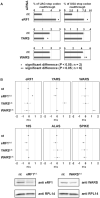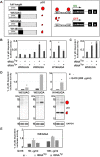Increased expression of tryptophan and tyrosine tRNAs elevates stop codon readthrough of reporter systems in human cell lines
- PMID: 34009360
- PMCID: PMC8136774
- DOI: 10.1093/nar/gkab315
Increased expression of tryptophan and tyrosine tRNAs elevates stop codon readthrough of reporter systems in human cell lines
Abstract
Regulation of translation via stop codon readthrough (SC-RT) expands not only tissue-specific but also viral proteomes in humans and, therefore, represents an important subject of study. Understanding this mechanism and all involved players is critical also from a point of view of prospective medical therapies of hereditary diseases caused by a premature termination codon. tRNAs were considered for a long time to be just passive players delivering amino acid residues according to the genetic code to ribosomes without any active regulatory roles. In contrast, our recent yeast work identified several endogenous tRNAs implicated in the regulation of SC-RT. Swiftly emerging studies of human tRNA-ome also advocate that tRNAs have unprecedented regulatory potential. Here, we developed a universal U6 promotor-based system expressing various human endogenous tRNA iso-decoders to study consequences of their increased dosage on SC-RT employing various reporter systems in vivo. This system combined with siRNA-mediated downregulations of selected aminoacyl-tRNA synthetases demonstrated that changing levels of human tryptophan and tyrosine tRNAs do modulate efficiency of SC-RT. Overall, our results suggest that tissue-to-tissue specific levels of selected near-cognate tRNAs may have a vital potential to fine-tune the final landscape of the human proteome, as well as that of its viral pathogens.
© The Author(s) 2021. Published by Oxford University Press on behalf of Nucleic Acids Research.
Figures






References
-
- Schimmel P. The emerging complexity of the tRNA world: mammalian tRNAs beyond protein synthesis. Nat. Rev. Mol. Cell Biol. 2018; 19:45–58. - PubMed
Publication types
MeSH terms
Substances
LinkOut - more resources
Full Text Sources
Other Literature Sources

